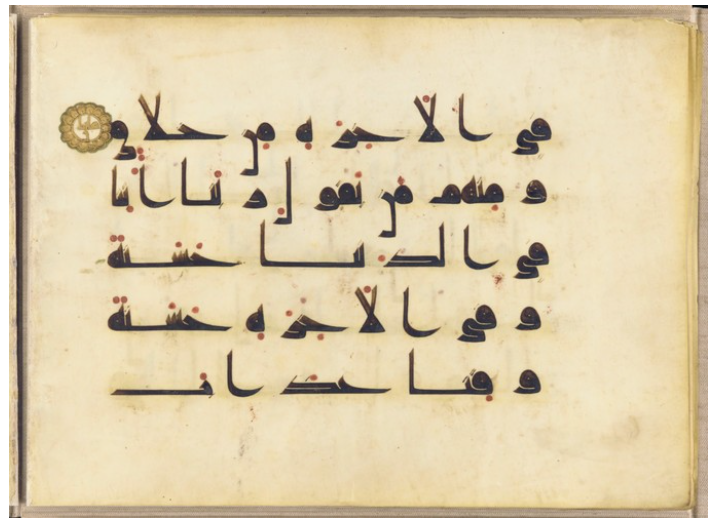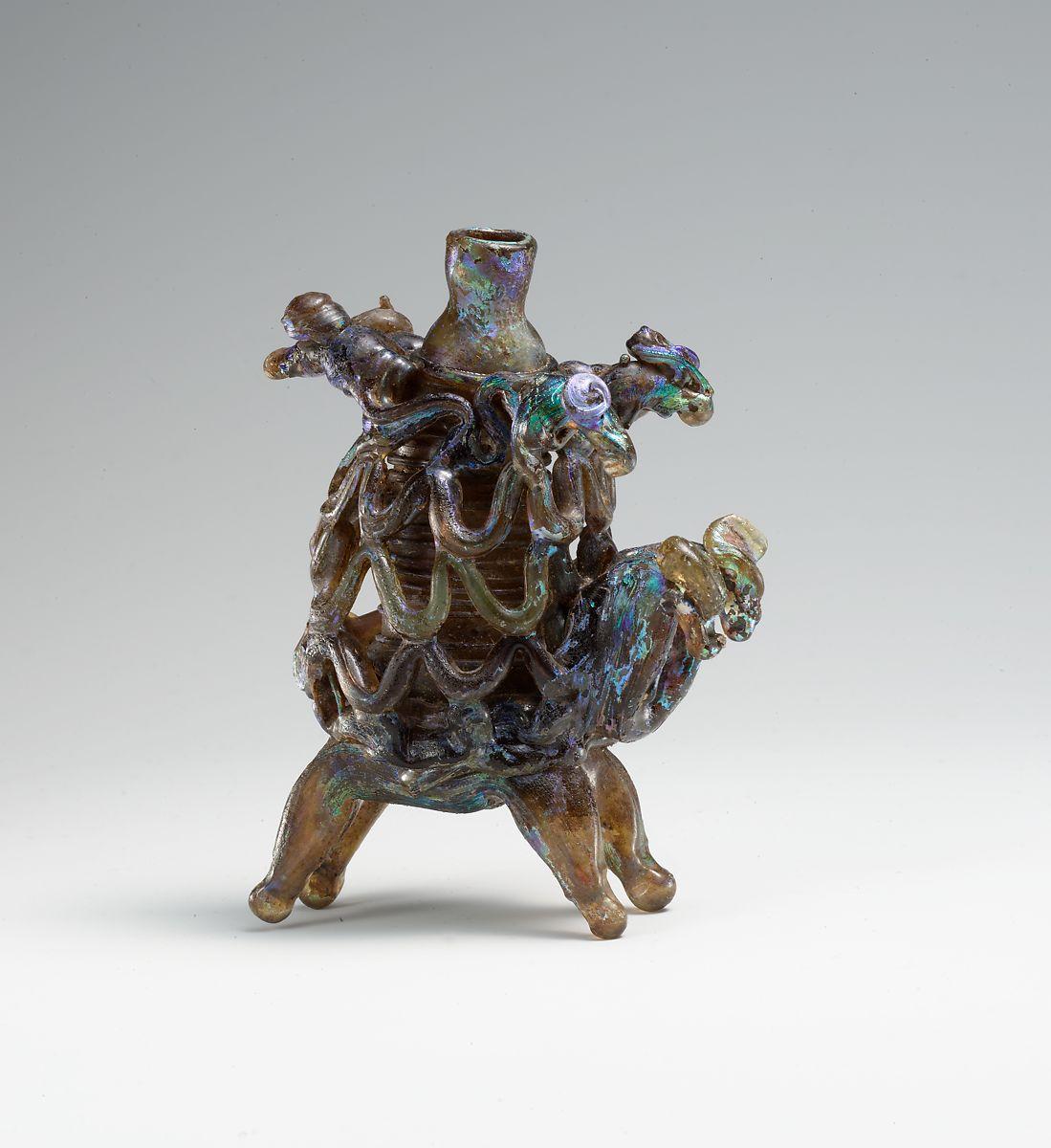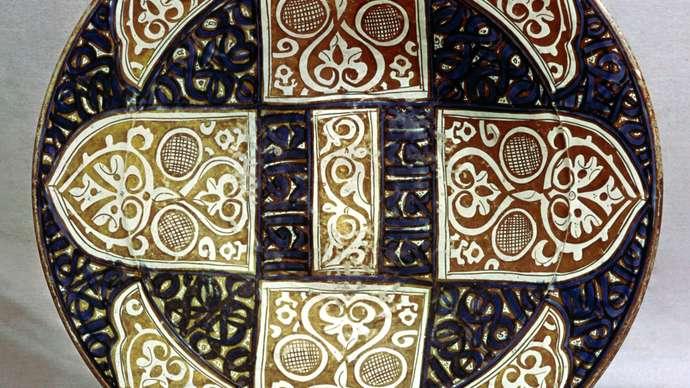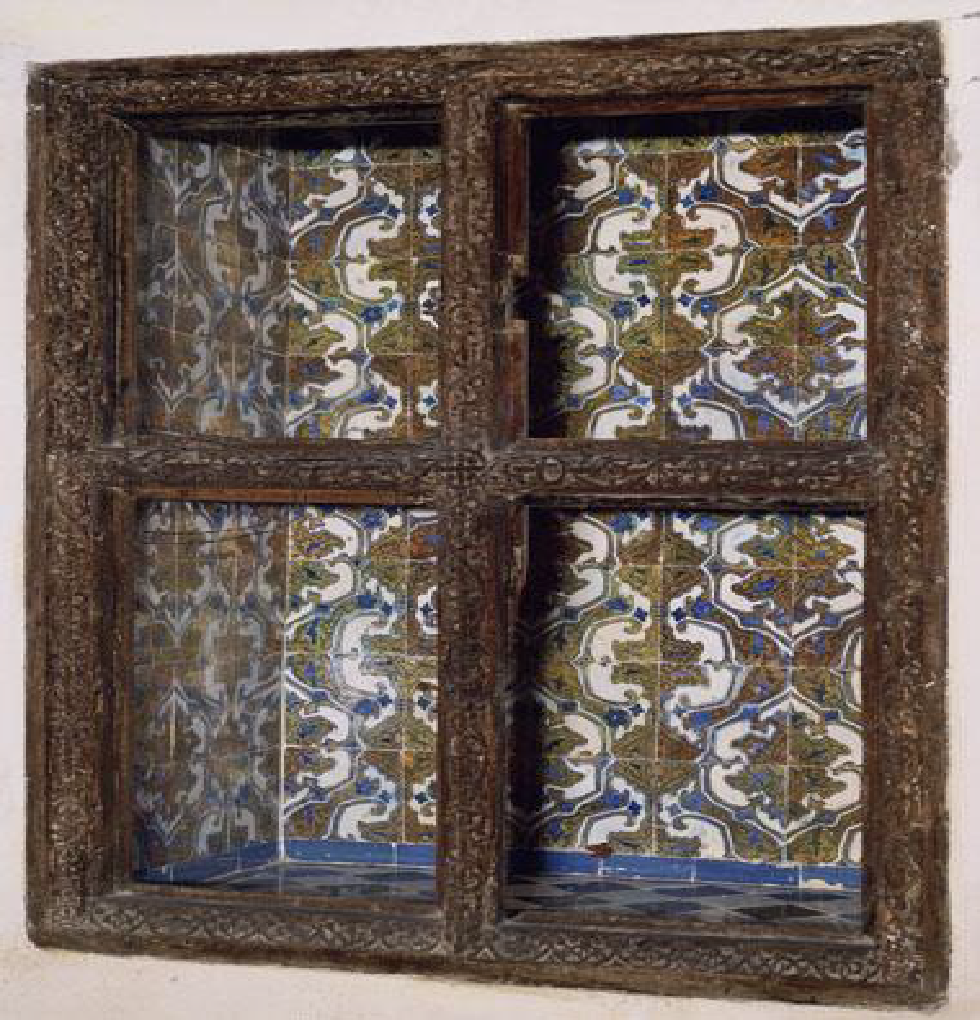Islamic architecture represents a mixture of secular and religious styles dating to the origin of Islam to the contemporary world. The architecture works reveal various factors that contributed to the uniqueness of this art, including cultural interaction and religious affiliations. While these architectural components remain one of Islam’s identities, the religion is against imitating most of its materials. A prohibition has been weakened by the outstanding calligraphy, vegetal motifs, geometric patterns, and floral patterns of the Islamic architecture works. These works take various forms, including manuscripts, portable arts, fresco paintings, and mosaics. Most of these art dates back to the early years of Islamic foundations and have undergone a series of evolution and refinement that give them identity and quality in the modern world. This essay seeks to explore Bifolium from the “Nurse’s Qur’an” (Mushaf al-Hadina), the animal flask, and the Hispano-Moresque, analyzing their historical context and relation to historical events. In addition to that, the paper provides personal meanings to early arts by examining their unique architectural forms.
Islamic art encompasses artwork produced in regions dominated by the Islamic religion or regions ruled by the Islamic leaders. The artwork spans several years when art was used to communicate sophistication through vegetal motifs, geometric patterns, and floral patterns. There are many who perceive the interpretation of the Islamic architectural arts as having an identity concept where the art provides natural, cultural and social identity to the Islam religion (Prima, 2021). Whereas many support this line of thinking, it is of particular importance to understand the dynamics of the cultural interactions that shaped the Islamic art to obtain a comprehensive interpretation of the architectural works. This essay explores the Islamic architectural arts through a descriptive analytical method of the various architectural elements and their interpretation while attempting to provide a comprehensive perspective of the art’s interpretation. Although there is a prohibition of figural imagery in the Islamic community that has diluted traditional architectural forms, Islamic work retains its unique identity and intrinsic quality in the contemporary world.
Bifolium from the “Nurse’s Qur’an” (Mushaf al-Hadina)
The piece denotes a double-page manuscript written in a ‘new style Kufic’ script unique to the North African dwellers. It features brown ink calligraphy on parchment embroidering green, red and blue marks. Furthermore, each page features contrast amid thin vertical characterized by ‘new-style’ script and thick round forms. The manuscript demonstrated that the ‘new style’ script was traditionally related to eastern people. The Kufic script is the earliest calligraphy, renowned for the angular form where the Arabic language is read from right to left, vocalizing the consonants (Ekhtiar, 2018). In contrast, the black ink, such as in figure 1 below dating back to the 9th century, displays consonants for the reader. It was commissioned by a female servant associated with the medieval royal household (Islamicart, 2021). The manuscript depicts the power of the women through wealth and piety, as indicated by their position in the Zarid court. The zarid court had Berbers governing the territories of Ifriqiya, central North Africa.

The Islamic religion prohibits the use of figurative language, equating such practice to be idolatry. However, the use of artwork to communicate religious views was not limited by the pious. These forms of communication spread mainly due to the mystery behind religious beliefs. Having such artwork commissioned by women further illustrates the power of women in the earlier Islamic years. The women held a level of power and wealth that continues to be demonstrated through their ability to maintain high places of power in the modern world. Moreover, this manuscript indicates the importance of information sharing, as seen by the commissioning of the earliest form of calligraphy involving two vocal languages of consonants and vowels. The interaction of such vowels using angular forms of writing indicates the interaction between the Arabs and the North African dwellers (Tunishia), who could only engage through signs that later formed words. The Kufic script portrays power, innovation, transformation, and the importance of communication.
Animal Flask
The animal flask dates back to the 7th and 8th centuries in Roman and early Islamic times. This architectural object was demonstrated through animal-shaped vessels consisting of glass tubes, either quadruple or double (The Met Museum, 2021). In addition to that, this artwork was trailed using glass threads while the tubes carried on their backs the domestic animals. It also featured trailed threads that resembled protective cages. The depiction of this artwork provides architectural sophistication of the Islamic religion by using art to give identity their cultural uniqueness. In addition, it’s the architectural element that enhances the Islamic religion’s identity (Ratodi, 2018). The use of Islamic architecture propagates Islamic ideologies in society through humans’ socialization and educative nature as an element of curiosity.
In addition to that, most animals displayed protective cages in the artwork, demonstrating the Islamic religion’s domestication nature and use of the animals. Most intriguing is the quadrupled animal bottle that mostly comprised of camels. It portrayed a figure supporting a slender tubular flask and was referred to as a container for balm. The figurine included a cage being constructed around the vessel, which gave the Islamic artwork containers the identity as posing some valuable product. The cage built used divers trails composed of contrasting colors such as dark blue and colorless, thus transforming it to chromatic variety. The use of this architecture has been interwoven into the contemporary world to communicate the use of religion as a form of socioeconomic advantage.
Furthermore, these figurines were used in trading and the spread of Islamic ideas by integrating opinions and beliefs, giving the religion a unique identity. The architectural art involving cages and animals provides the Islamic religion with an intrinsic quality of packaging and transportation of perfumes in the traditional days. The art work has been exemplified in the modern world to depict wealth associated with quality as described in the museum. Furthermore, the artwork has provided the Islamic religion with identity as they view the animals used in the art work to be desert animals such as camel. They appreciated and recognize themselves as the desert people with wealth and sophistication. Today, one can only imagine how the artwork communicates to the location, means of transport and ways of preservation used by the Islamic religion in the traditional days.

Hispano-Moresque Style
Islamic Ceramics
There has been a substantial achievement in Islamic ceramic tiles and pottery, and the early pottery displayed a tin-opacified glazing technique. The first of such opaque glazes is dated around the 8th century and features blue-painted ware. Stone paste ceramics originating from the 9th century have also depicted quality and identity in the modern world. Several interactions occurred during the Moorish Revival leading to the interaction of diverse cultures that finally culminated in the development of Hispano-Moresque (Baillot, 2019). However, the lusterware remains by far an excellent demonstration and appreciation of Islamic architecture. A type of porcelain and pottery with an iridescent metallic glaze was initially used as a painting method in glassmaking and later translated into pottery in the 9th century. The evolution of Islamic architecture dates back to medieval days portraying its quality and complexity. However, with the evolution was the use of style, which led to the Hispano-Moresque style, which originated in the 8th century under the influence of the Egyptians.
The Hispano-Moresque style can be illustrated in two distinct architectural forms; glazing possessing opaque white tin-glaze and metallic lusters paintings. The technique was architecturally deployed to manufacture glass and pottery utilities that give an identity of wealth displayed in quality. The lusterware demonstrates Islamic tradition through decorative arts even through significant changes in rulership, which brought some unique evolution to the lusterware. The Mudejar lusterware dish is an example of such development in the architectural formation of Islamic art. It borrowed the Spanish decorative arts and architectural ornament. Over the years, the luster has been used in various pottery and paintings, as well as tile making.
The contemporary world has significantly benefited from the quality works demonstrated in tile making, as displayed in figure 3. Luster colors and a metallic shine with arista contours were later added to the Hispano-Moresque style in tile production (Coentro, 2017). There evolved Valencia painted tiles featuring brush painting, flat white tin-glazed tiles, and the Valencia blue-and-white luster ceramics from these styles. The Spanish and Portuguese interaction led to the advancement of various architectural forms (Prima, 2021). The modern world can recognize the Islamic architectural work that communicates identity and wealth through the Hispano-Moresque style. Such is displayed through tiles, pottery, and paintings which give Islamic art an exquisite taste.


Annotated Bibliography
Baillot, E. (2019). Jean-Charles Davillier’s Network: Artists, collectors, scholars, and the Moorish revival. Art in Translation, 11(2), 241-262.
This article explores the Moorish Revival in architecture, decorative arts, and paintings during the ninth and tenth centuries. The authors undertake a retrospective study into the lives of the most influential cultures and individuals in Moorish and Europe. The research establishes that Moorish Revival led to interaction between cultures that led to the procurement of various architectural components. Islamic architecture encompasses diverse cultural heritage from its interaction with other cultural groups.
Coentro, S. X. (2017). An Iberian Heritage: Hispano-Moresque architectural tiles in Portuguese and Spanish collections [Doctoral dissertation, Universidade NOVA de Lisboa (Portugal)].
This publication is an archaeometry study of Hispano-Moresque tiles by comparing Spanish and Portuguese collections from the Islamic religion. The author introduces the historical-artistic age through ceramic tiles and explaining the Portuguese and Spanish controversies. As observed through the Hispano-Moresque, the quality seen in modern works prompts the author to admire the fine historical works of the Portuguese and the Spanish culture.
Ekhtiar, M. D. (2018). How to read Islamic calligraphy. Metropolitan Museum of Art.
This publication explores the earliest form of calligraphy referred to as Kufic and the means of reading the various calligraphy. The author takes a retrospective study into the early historical years to explore the mysteries behind the earliest calligraphic works that demonstrated Islamic architecture. The calligraphic artwork is an architectural product of diverse cultural interactions that shaped their reading and writing with various angular forms.
Islamicart. (2021). Bifolium from the ‘Nurse’s Qur’an’ (Mushaf al-Hadina).
The Islamic cart museum provides Islamic architectural works on display through an artistic angle, such as calligraphy depicted in the Bifolium. The museum takes an informative approach by highlighting the main features of the collection understudy before describing the object in question. The piece then gets descripted through the historical angle where the museum attempts to draw curiosity and exploratory nature in the audience. Through the manuscript, it is clear that Islamic architectural works had quality and unique features as well as rich content.
Ratodi, M., A’yun, Q., & Hapsari, O. E. (2018). The people’s understanding on Islamic architecture: A study of Indonesian.
This research explores the discourse in Islamic architecture concept based on the geographical spread and local context. The authors study Islamic architecture in the building context as relatively understood in Hadith and the Quran. Thus, the article provides a deeper understanding of the extent of the influence of Islamic architecture on society. It also informs on the societal factors such as education and socialization as requirements for the development of Islamic architecture.
The Met Museum. (2021). Animal flask.
The Met Museum delves into Islamic artwork by exploring and displaying specific collections that spark curiosity and admiration for the quality and architectural skills. The museum uses an informative approach to provide information on the animal flask under two zoomorphic bottles. The flasks were figurines that depicted complex animal and cage architecture through threads and diverse patterns.
Prima, E. C. (2021). The role of culture on Islamic architecture. Jurnal Kajian Peradaban Islam, 4(1), 30-34.
The article explores the factors behind the architectural elements in the Islamic religion, particularly the influence of culture. The author attempts to explore the concepts of adoption and adaptation and their effect on architecture. A descriptive-analytical to examine Islamic views from various sources of literature was used. The authors determined that various transactions occur when two cultures interact; this leads to an interchange of beliefs that eventually shape the architecture of one another.
References
Baillot, E. (2019). Jean-Charles Davillier’s Network: Artists, collectors, scholars, and the Moorish revival. Art in Translation, 11(2), 241-262.
Coentro, S. X. (2017). An Iberian Heritage: Hispano-Moresque architectural tiles in Portuguese and Spanish collections [Doctoral dissertation, Universidade NOVA de Lisboa (Portugal)],
Ekhtiar, M. D. (2018). How to read Islamic calligraphy. Metropolitan Museum of Art.
Islamicart. (2021). Bifolium from the ‘Nurse’s Qur’an’ (Mushaf al-Hadina).
The Met Museum. (2021). Animal flask.
Prima, E. C. (2021). The role of culture on Islamic architecture. Jurnal Kajian Peradaban Islam, 4(1), 30-34.
Ratodi, M., A’yun, Q., & Hapsari, O. E. (2018). The people’s understanding on Islamic architecture: A study of Indonesian.